This is it – this is the big one. The test that’s been seven years in the making, during which we’ve endured all the teaser images, the grainy spy shots, the carefully managed prototype drives, the international launch and then brief blasts in the UK. But now, finally, the Toyota Supra is out in the wild, free of its minders and ready to do battle.
Those early outings hinted at a car that had the potential to be the real deal, but we needed more than a few miles on a carefully choreographed route to deliver the definitive verdict on one of Toyota’s most eagerly awaited offerings in years, especially one that has painted big red targets on the back of some of the biggest hitters in the sports car firmament.
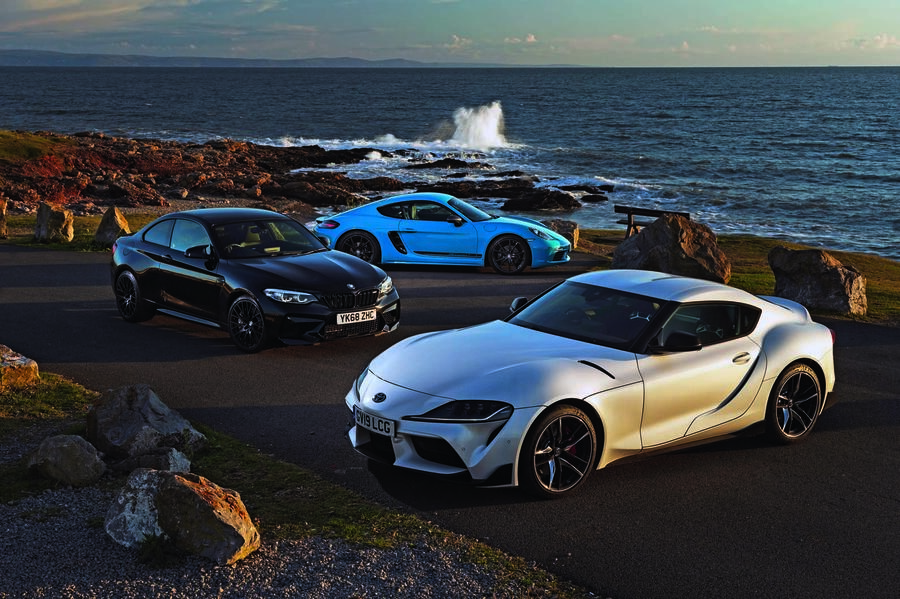
Of course, the Supra’s arrival hasn’t been without controversy, its relationship to its dizygotic BMW Z4 twin proving more obvious (on the inside, at least) than many had hoped. Yet while Bavaria provides the 335bhp turbo straight six, eight-speed ZF automatic transmission and electronic slippy diff, plus the electrical architecture and switchgear, Toyota claims the Supra’s wide track and short wheelbase – the perfect combination for the intended acrobatic agility – are Japanese to its steel and aluminium core.
So how serious a sports car is the Supra? Well, there’s only one way to find out, which is why we’ve headed for some of South Wales’ most testing Tarmac in close convoy with a pair of formidable foes.
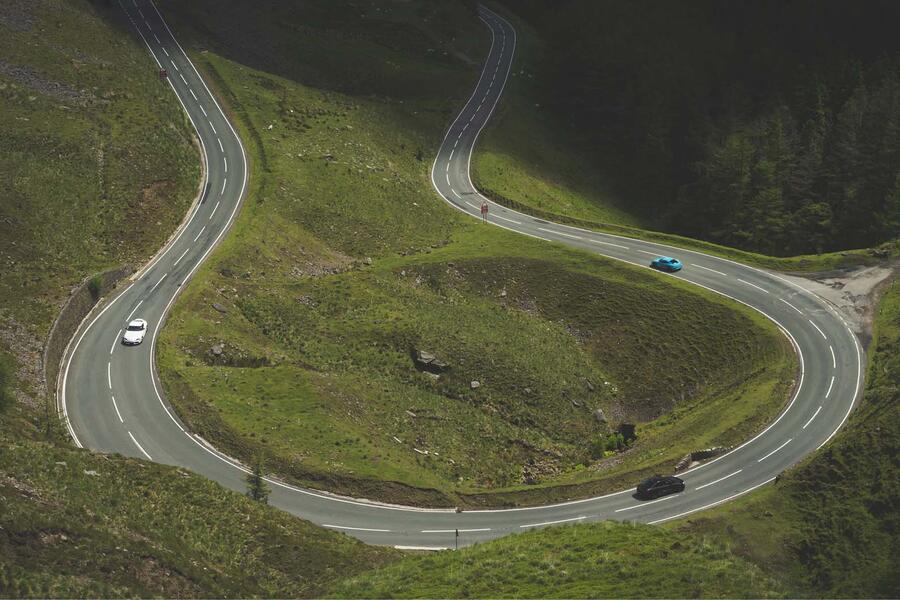
Looming largest in the Toyota’s sights is the Porsche 718 Cayman. In freshly released T form tested here, it’s currently the purest and most driver-focused version of Stuttgart’s starter sports car, featuring a 20mm lower ride, a torque vectoring differential and a small reduction in weight – surely not all of it courtesy of the looped fabric door handles. Yes, its mid-engined layout is at odds with the Toyota’s more traditional take on arranging the mechanical masses, but the Cayman is the car that chief engineer Tetsuya Tada has consistently identified as the benchmark for his baby. With 296bhp from its 2.0-litre flat four, the Cayman is the most weak-kneed here, but also the lightest at 1350kg. Furthermore, it’s got a snappy six-speed manual (a seven-speed PDK is an option) – the Supra is self-shifting only.
The BMW M2 Competition is more small sports saloon than true coupé but, as a beefy front-engined rear driver, it’s not only one of our favourite proponents of the Système Panhard, it’s ideologically (as well as genetically) closely linked to the Supra. Moreover, the 404bhp M2 has by far the greatest amount of firepower here. Like the Porsche, you can have a three-pedal version but, to complete our trio of different transmission options, we’ve gone for the seven-speed dual-clutch option.
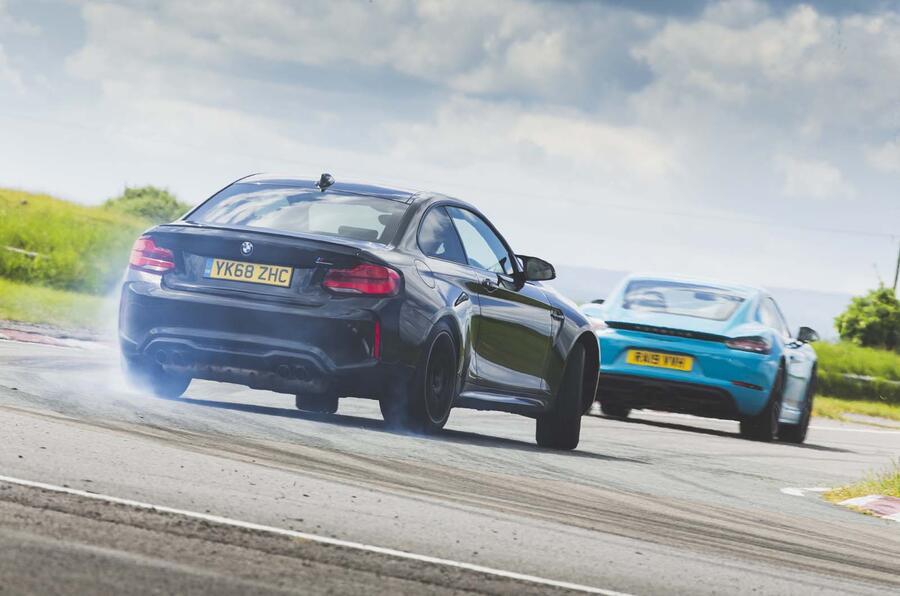
Despite their wildly divergent approaches, they all have a common goal, which is to get drivers’ synapses sparking and senses tingling by dishing up gobfuls of driver fun. The fact that they’re all around the 50-grand mark doesn’t hurt either. This is going to be close.
Styling is clearly subjective, but to our eyes the Supra draws first blood. It’s not just the car’s newness that attracts attention and multiple thumbs up wherever we go, it’s the eye-catching mix of confident curves, creative creases and daring lines. It’s fussy in parts and the fake vents in the bonnet and doors are tacky, but overall it’s a corker.
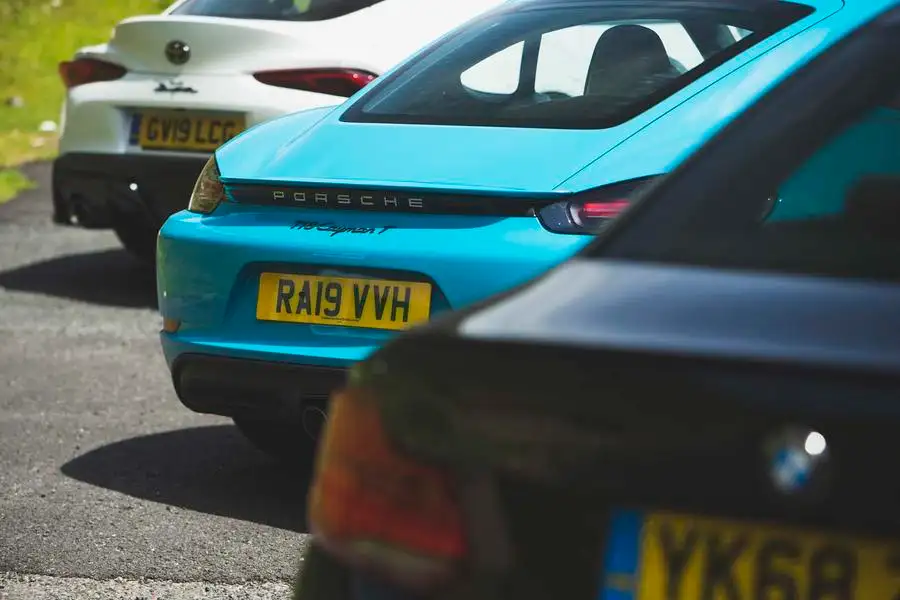
Even in its retina-burning Miami Blue paint job (that’ll be £1658 to you, sir) with natty Cayman T stripes along the bottom of the doors, the Porsche fades into the background when sat next to the Supra. And while the M2’s wide-arched, thuggish stance isn’t without appeal, the bluff three-box BMW lacks the sleek sophistication of the other two.
Swing open the Toyota’s long door and duck inside (watch your head on the low roof), and you’re instantly in sports car territory. The letterbox view ahead and compromised rear vision are at odds with the panoramic Porsche and slightly sit-up-and-beg BMW, but you’re snug and low in the Toyota, ensconced by the tall transmission tunnel on one side and high window line on the other. Like the Cayman, the recumbent driving position is spot on; you’re equally comfortable in the BMW but, after a stint in either of the other two, you feel like you’re sitting on the car rather than in it.
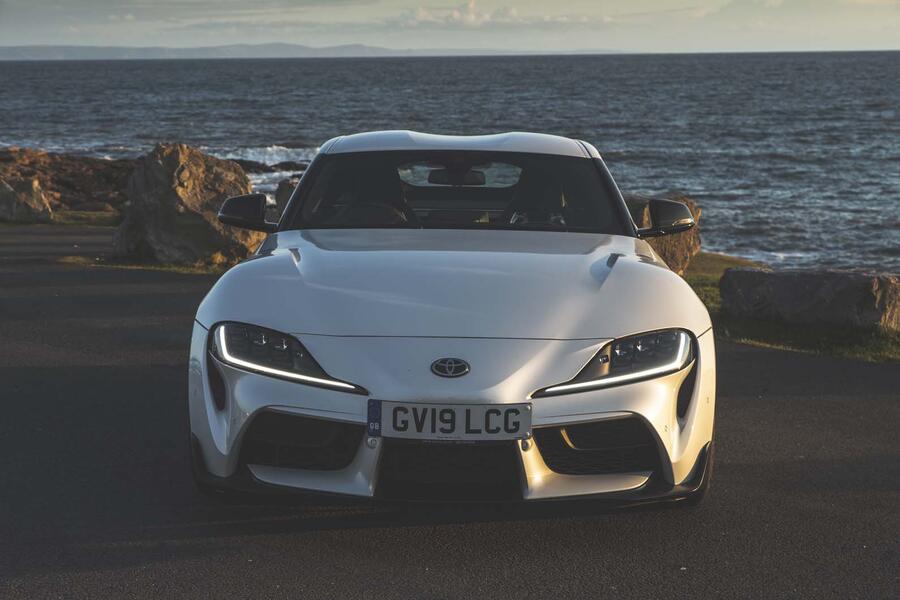
At first, the Toyota’s BMW-sourced switchgear is a little jarring, yet these components are so well integrated and handily sited, you quickly forget about where they come from. What’s more, anyone who’s grappled with the Japanese brand’s truculent Touch 2 infotainment will be overjoyed at having a reskinned version of BMW’s more intuitive iDrive. More to the point, the German extras add a sheen of class to the interior, allowing it to almost match the exquisitely executed Porsche for upper-class ambience.
Like the Cayman, it’s decently practical, too. There are numerous cupholders, a large glovebox, handy door bins and a 290-litre boot beneath a large yet narrow hatchback. The Cayman has less stowage for oddments, but its twin-boot arrangement means you can carry more luggage. Of course, if you need more space for people and things, the four-seat BMW is your only choice, but all are everyday-usable.
Enough of the practicalities – let’s get going. First up is the Toyota and the first surprise is just how supple it feels, dealing with bumps with a deft plushness. The secondary ride can get a little lumpy but, compared with the stiff-legged and hyperactive BMW, the Supra feels like an executive saloon. Even the Porsche is firm by comparison, although its brilliantly calibrated adaptive dampers round off all the sharp edges. None of these cars is particularly sybaritic – there’s too much road noise for that – but on the long slog to Wales, it’s the supple and long-legged Supra (70mph registers 1800rpm on the TFT rev counter) that’s the most soothing.
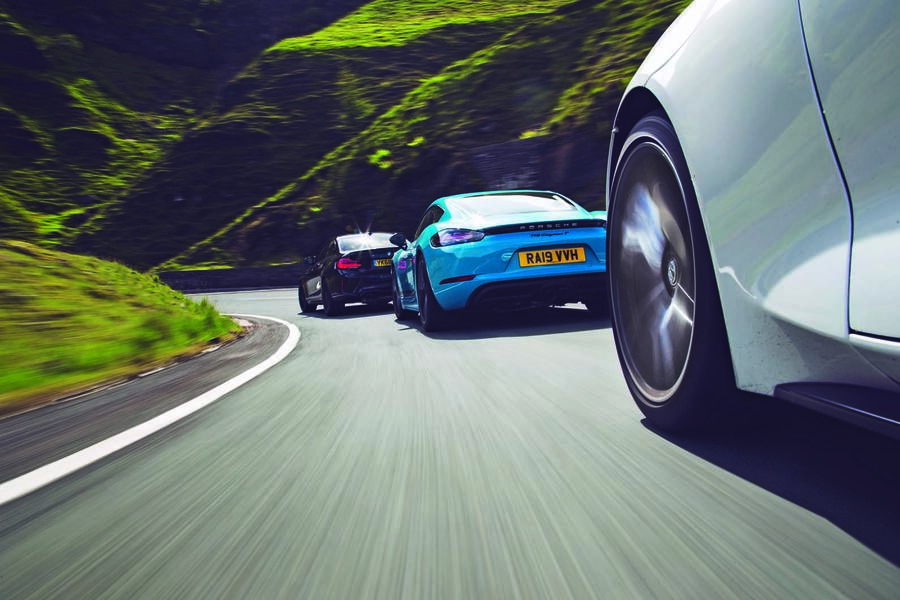
Yet don’t mistake its easygoing gait for softness, because the Toyota runs hard when you need to. The BMW B58 3.0-litre unit delivers its 368lb ft at just 1600rpm – and it’s this instant muscle that dominates, giving the Supra an effortless elasticity that allows you to gobble up straights at an alarming rate. In fact, in the low to mid-ranges, the Supra feels like it’s punching as hard as the brawnier BMW, a sensation that’s heightened by the closely stacked intermediates of its eight-cog ’box, a snappy throttle response and strong traction from the relatively compliant multi-link rear axle.
So it’s a shame the Supra doesn’t sound better. Yes, it’s smooth and revs freely – only getting a bit constricted over the last 500rpm or so before the redline – but from behind the wheel there’s a strange synthesised quality to its note, even though there’s no augmentation of any kind. It’s not unpleasant, but you’d expect more authenticity given the Supra’s brief. You also can’t help wishing it revved out as eagerly as the M2’s bona fide BMW Motorsport S55 straight six, and matched its top-end bite and addictive mechanical howl.
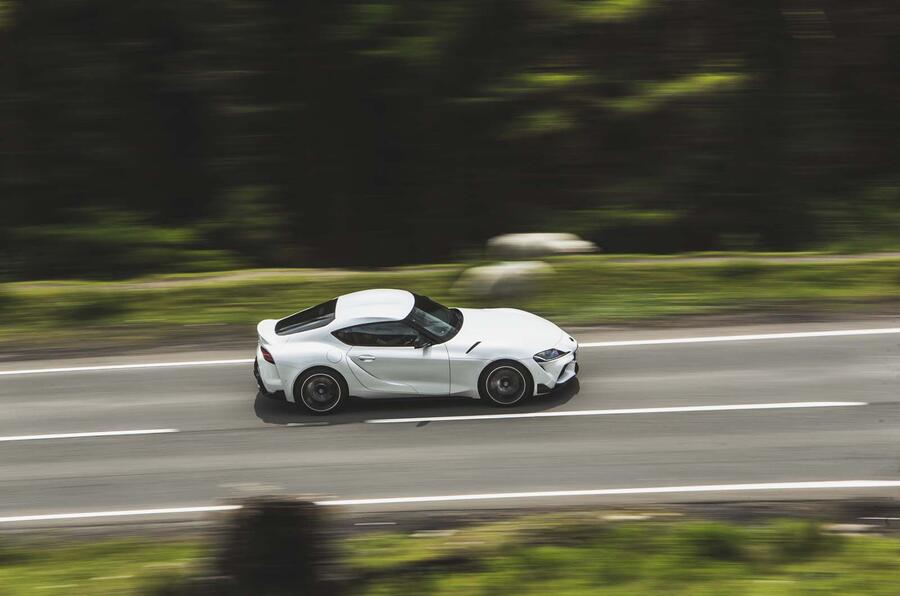
You want the Toyota’s torque converter automatic to operate as adroitly as the BMW’s dual-clutch transmission, too. The Supra’s shifts are quick and smooth enough on the way up the ’box, but it drags downshifts in a way that can upset the balance of the car. This will be anathema to a driver who is treated to the M2’s near-seamless changes, or one performing deft heel-and-toe downshifts through the Cayman’s snappy six-speed manual. Speaking of which, the Porsche’s ’box is sublime, benefiting from a short, precise throw that’s a joy to use. This is a good thing, because you’ll need to get busy with your left hand and leg if you want any chance of keeping the T in touch with the other two.
The early 718 flat fours weren’t exactly warmly received, but they were effective performers thanks to a welt of turbocharged torque. Yet recent developments – such as the addition of a petrol particulate filter – seemed to have robbed the boxer, in 2.0-litre guise at least, of any zest off the line. Peak torque of 280lb ft is said to arrive at around 2150rpm, but our example felt reluctant to get going at less than 3500rpm.
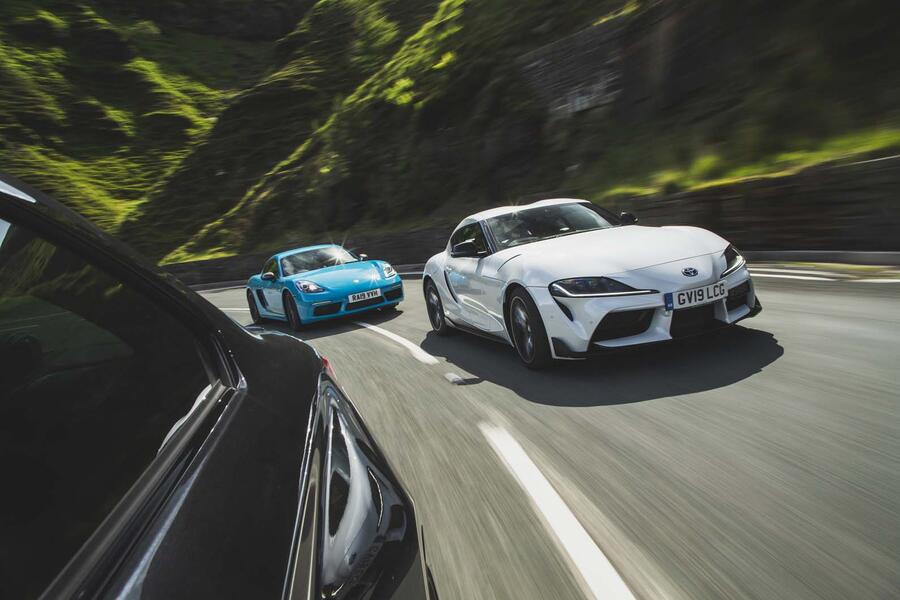
On give-and-take Welsh roads, changing down one gear often isn’t enough when caught napping, and instead you have to flick the stubby manual lever down two or three ratios to really get going, by which time the Toyota and BMW are a speck on the horizon. This lethargy is exacerbated by extremely tardy throttle response, which feels leaden even in Sports and Sports+ modes and has you momentarily thinking the brakes are binding on. From 4000rpm, the boxer unit wakes up and pulls hard, fizzing eagerly to 7000rpm, but it’s still accompanied by the characterless blare from the sports exhaust.
No matter, we’re deep into the heart of the Welsh valleys now, driving along corkscrewing, lumpily surfaced roads full of deceptive corners that keep you on your toes. Performance is important, but it’s the handling that matters here, and we’re in for a few surprises, not least just how capable the Supra is.
At first it feels bigger than the other two, a visual trick brought on by the long bonnet that stretches away through that narrow screen. But in reality the Supra proves to be biddable and entertaining. Its weighty steering is easily the quickest, forcing you initially to calm your inputs if you’re to accurately slice the apex.
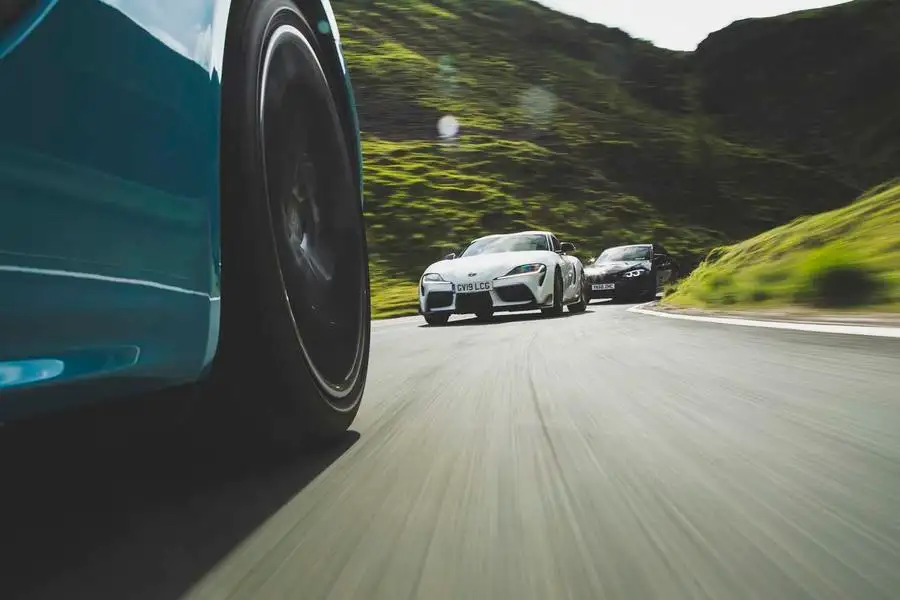
It’s not as chatty as the Porsche’s rack, but there’s enough feedback to tell you the Michelin Pilot Super Sports (the M2 is similarly shod, but with a slightly skinnier cross section) have got plenty of purchase. In fact, understeer is rarely a problem on the road. The combination of keen steering and short wheelbase helps to rotate the car – more lazily than the Porsche and with more roll, but fast enough to feel agile – towards the apex. At this point, you can use the car’s ample muscle to trim your line with the throttle, the relatively soft back axle and meaty 275-section rubber delivering just enough confidence-inspiring traction. Of course, you can make interesting shapes on the exit of corners if you want, though you have to mean it – this isn’t a car that’s going to step sideways unbidden, but the option to get expressive is there. The brakes are good too. They’re not as powerful and feelsome as the Cayman’s and there’s some grabiness at low speeds, but bigger stops reveal a progressive pedal and strong retardation. It’s not exactly a super-sized GT86, but it’s not far off. This is a car you can have fun in, and at relatively sensible speeds too.
That’s just as well because push really hard – particularly on some of the wickedly bumpy stretches – and the Toyota’s resolve is sorely tested. It never gets wayward but, even in their firmest Sport setting (the Supra is gratifyingly short on drive modes, with just Sport and Normal to choose from), the adaptive dampers struggle just a little to contain the more vicious vertical movements.
It’s a similar story for the passively damped BMW, which is great at nine-tenths, but go much harder – on these roads, at least – and its weight and higher centre of gravity start to show, the M2 often hitting its bump stops and getting generally jostled by torn Tarmac.
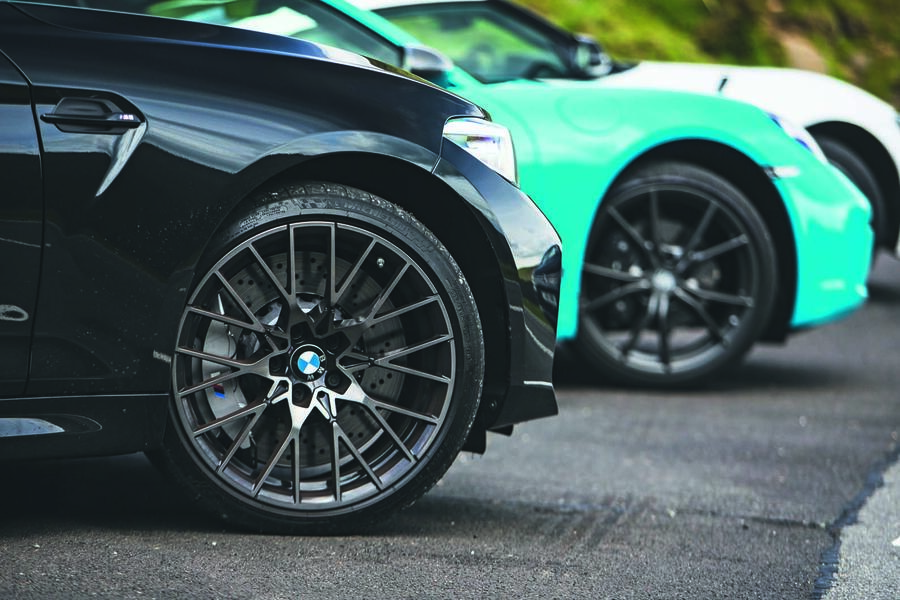
However, up to this point it’s a real riot, the M2 encouraging you to misbehave in a way the Supra and Cayman simply don’t. With a rippling 406lb ft, a short wheelbase, strong front-end bite and a solidly located rear axle, the BMW is a car that you direct as much with your right foot as the steering wheel. So approachable and clearly telegraphed are the slides that, in the dry, the temptation to remove the electronic safety net and experiment with ever-greater angles of attack is almost overwhelming. But massively improved though the Competition is over its predecessor, it still demands respect in the wet if you’re not to spend your time gathering sudden spikes of oversteer, while the jarring ride constantly niggles away at you.
Either way, it doesn’t matter how hard the other two try, they just can’t match the delicacy, balance, control or quick-wittedness of the Porsche. At first the steering seems slow, especially after the Toyota, requiring more lock than you expect to get the nose turned in. Yet it delivers by far the best feedback, plus you soon learn that slightly lazier rate of response allows you to more accurately load up the chassis, exploit the rapid rotation afforded by that low polar moment of inertia and spread the cornering forces equally between front and rear axle. It’s here that little lifts of the throttle can be used to achieve the subtlest shifts in attitude. You can even trim the line with a bootful of throttle. And because the Cayman has more grip than power, you’re never concerned it’s going to go further than you want.
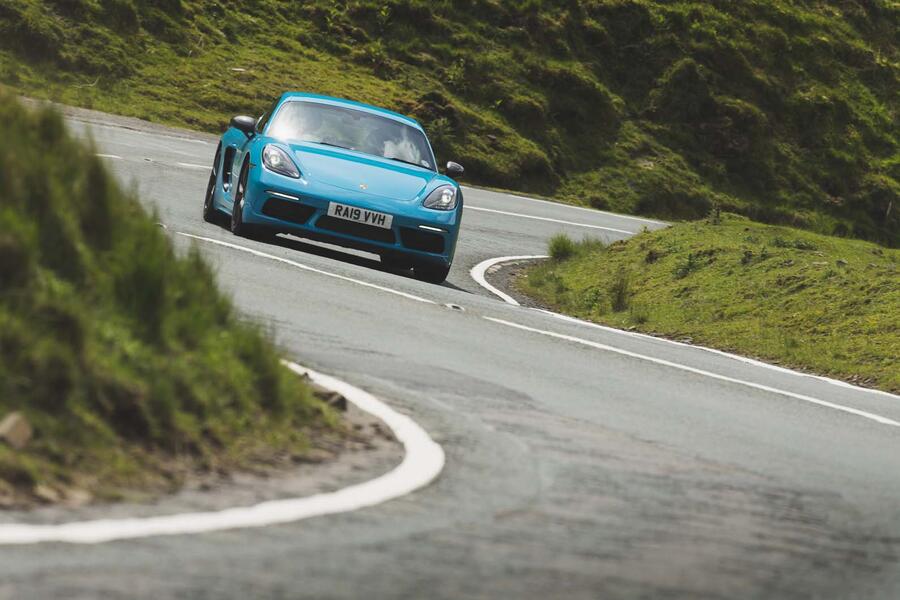
Moreover, it’s totally unfazed by the ragged bumps that get the BMW bottoming out and the Supra skittering. Sport+ mode is too firm for the road, but in Sport the Porsche simply steamrollers these surfaces, cornering flat and with a cast-iron control that leaves you slack-jawed at the magic that’s been weaved on the chassis. It’s the most rewarding, nimble and engaging car here, and in terms of handling, the purest and most complete sports car.
So that’s a win for the Porsche, then? Not so fast. All of these cars are touched with brilliance, yet none is perfect, and as verdicts go this is one of the toughest, and closest – and we mean really close. The Cayman’s chassis is sublime and in the past that would have been enough to offset the four-cylinder motor’s lack of charm. But so flaccid and flatulent is this example’s engine that it’s impossible to overlook. No matter how brilliant the Porsche is in the twisties, you’ll be cursing its lethargy and hoarse vocals along the straights.
In many ways, the rabble-rousing M2 is the very antithesis of the Cayman. You would never tire of that firecracker of an engine, particularly when it’s mated to a manual ’box, while its hooligan handling delivers moments of pure, childish joy. Really test its chassis, though, and it struggles to disguise its more humble origins. It’s still a cracking piece of kit but, in this company, it always feels like the ultimate development of a saloon rather than a pure-bred sports car, and as such finishes just a fraction behind the Cayman.

So that leaves the car in front as a Toyota. Yet this is a victory that’s achieved almost as much by the flaws of its rivals as it is by its own impressive abilities, and perhaps against a punchier Cayman S the tables would be turned. The truth is that the Supra is still around 10% away from real greatness – it’s crying out for a more soulful-sounding engine, a smidge more damping control and a better gearbox (how about a manual?).
That said, let nothing be taken away from the Supra’s incredible achievement here because, despite its foibles, it’s a hugely entertaining sports car with a character and charm of its own – a car that is worth taking for a drive just for the hell of it, yet arguably the easiest to live with day to day.
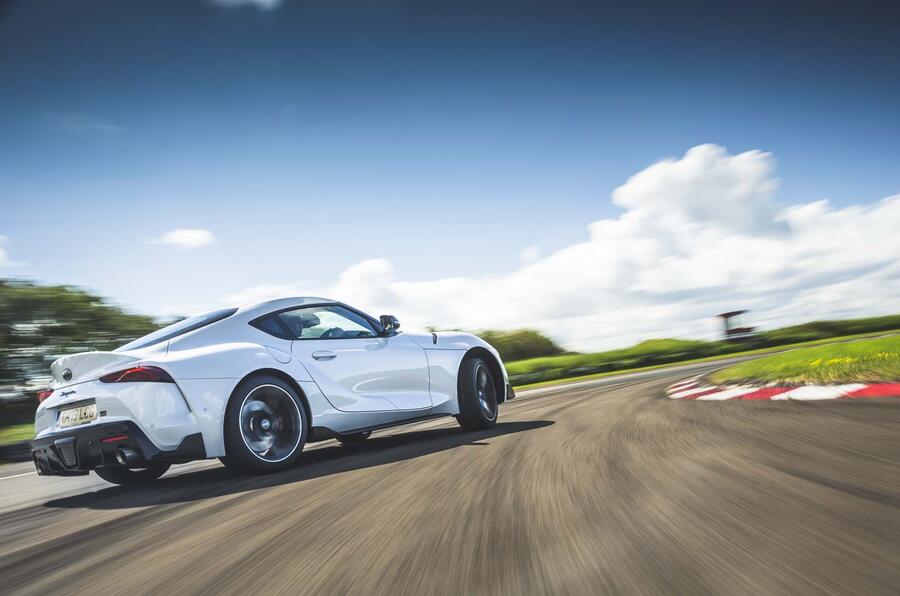
So right here, right now, the Supra scores – but it’s far from ‘job done’ yet for Tada-san and his team.
Here's some they made earlier
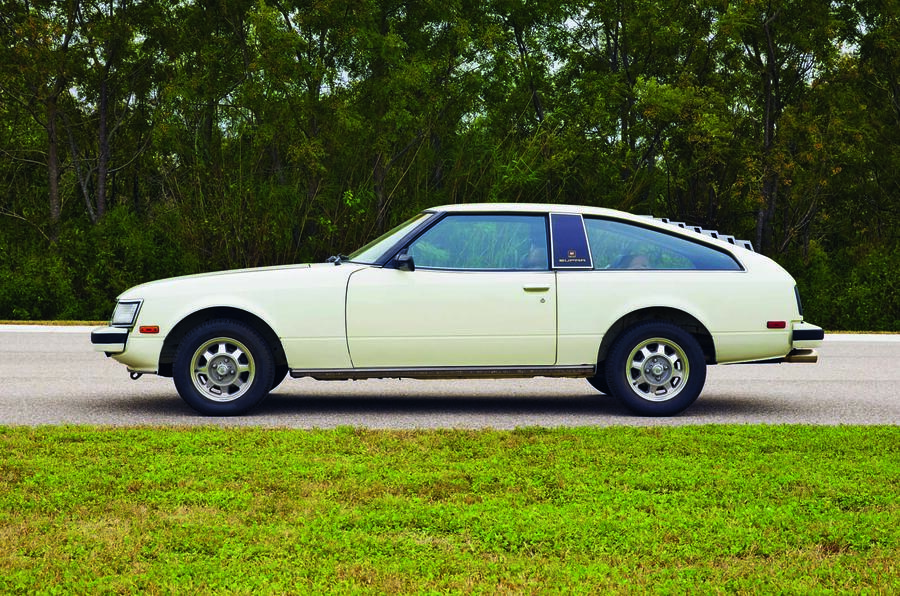
Supra Mk1/2: The original Supra was no more than a tarted-up version of the humble Celica with a longer nose and lengthier wheelbase. However, the Mk2 that launched in 1981 offered truly wedgy styling, retractable headlights and flared wheel arches. British buyers were offered a 178bhp 2.8-litre twincam engine and, with a suspension breathed on by Lotus, it was a truly tempting package. Mechanicals are strong but all of them are very old so check everything carefully. Put aside £6k for a decent runner.
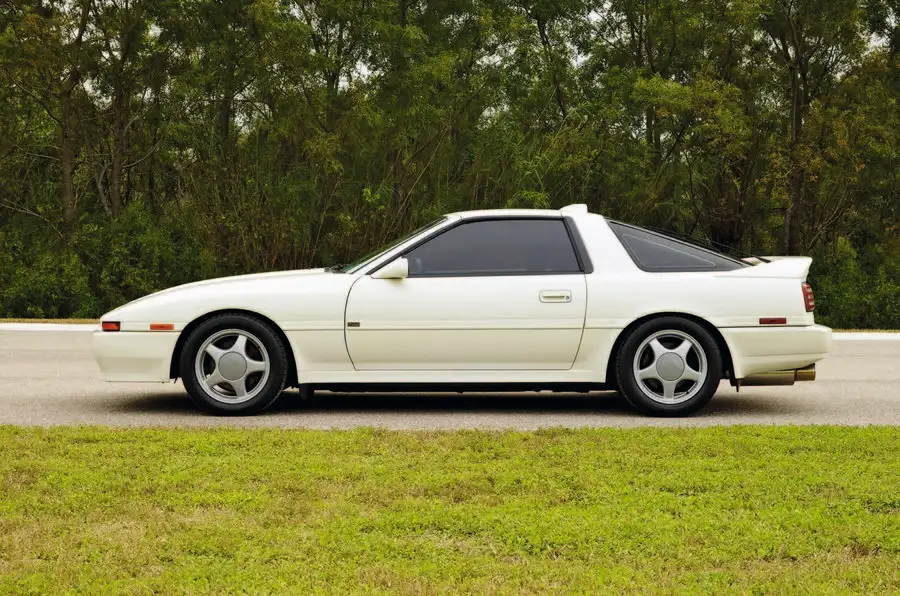
Supra Mk3: The Mk3 Supra’s angular styling looks dainty now but back in the ’80s this four-seat grand tourer actually had a rather butch image. It helped that there was a muscular turbo version of its 3.0-litre straight six, a car that dismissed 0-60mph in just 6.1sec. The aftermarket loved them, as they did all Supras, and your chance of finding an unmolested one now is pretty slim. Turbo engines could give trouble in the head bolt area and rust is a killer. Figure on £6k- £10k as a starting price.
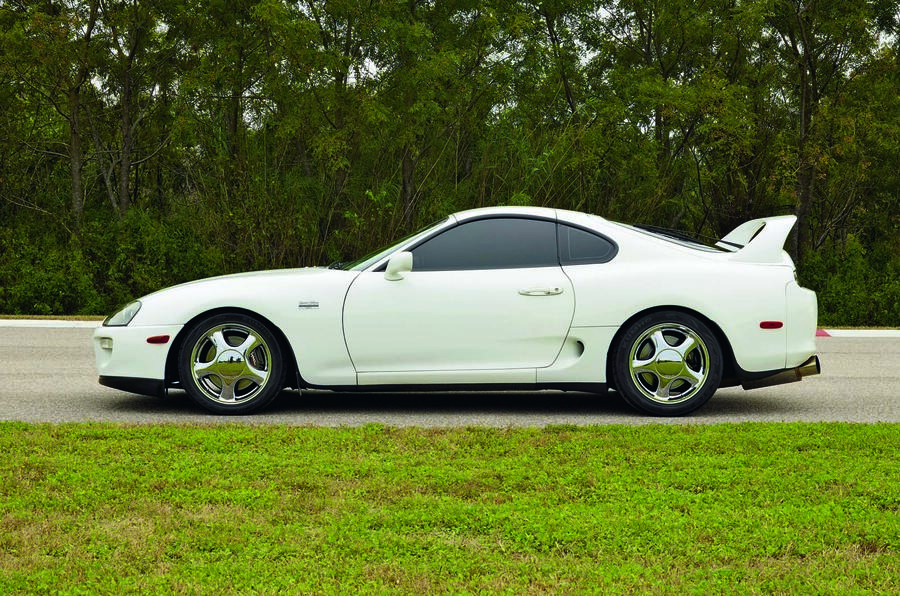
Supra Mk4: It was never actually a huge seller here and hasn’t been officially seen in the UK since 1996, but the purposeful Mk4 Supra has now attained semi-iconic status. It was shorter, lower and wider than the outgoing model, and much lighter too. It came in 3.0-litre straightsix naturally aspirated form or sequential twin-turbo, but only the blown version made it to the UK, and those buyers could then opt for a six-speed manual or four-speed auto ’box. Performance? 0-60mph in just 4.6sec and the top speed reined in to a ‘mere’ 155mph.
This article was originally published on 29 June 2019. We're revisiting some of Autocar's most popular features to provide engaging content in these challenging times.
Read more
New Porsche 718 Cayman GT4 and Boxster Spyder revealed with 414bhp flat-six​
BMW M face-off: M3 CSL vs. M2 Competition

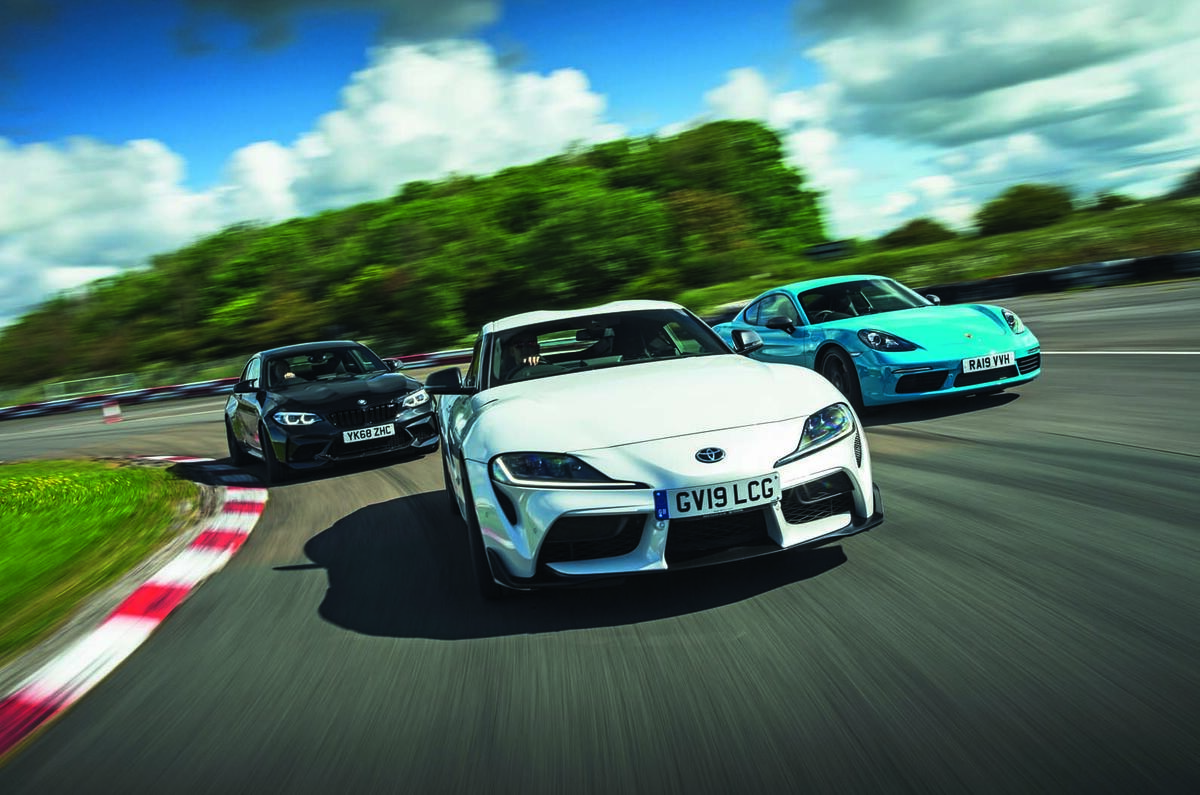
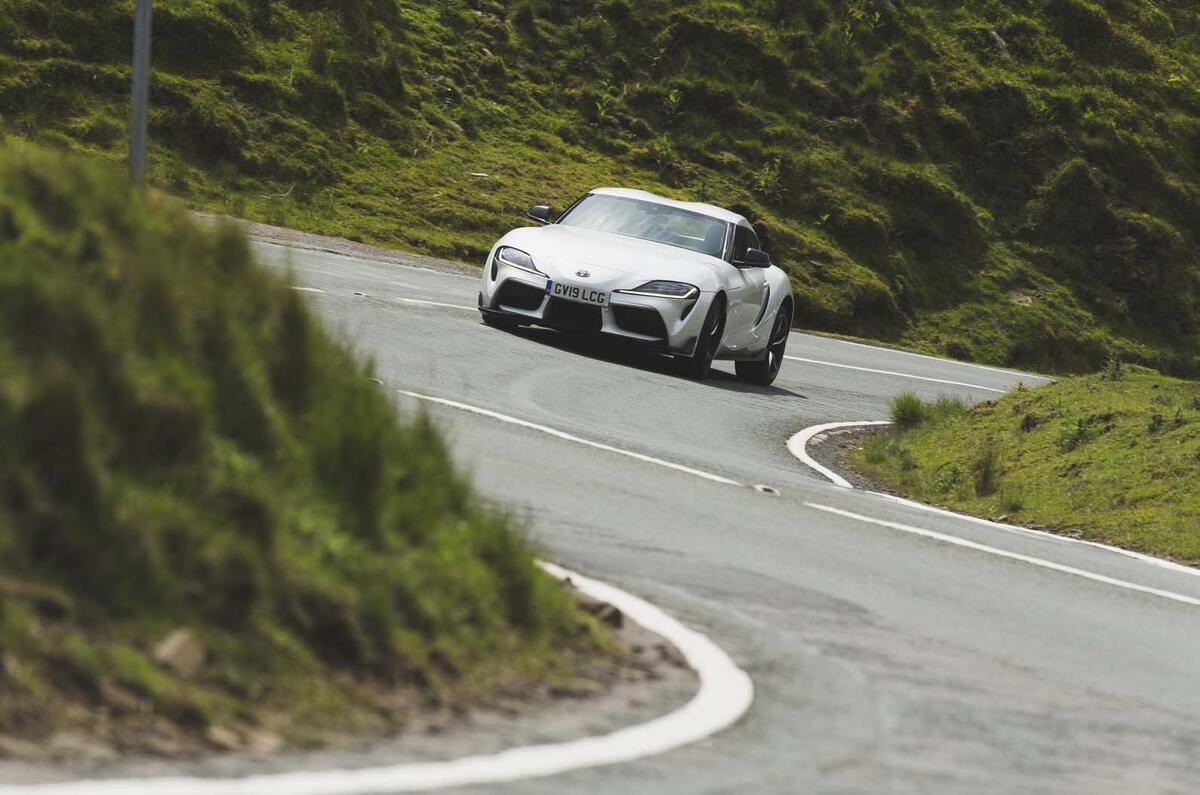

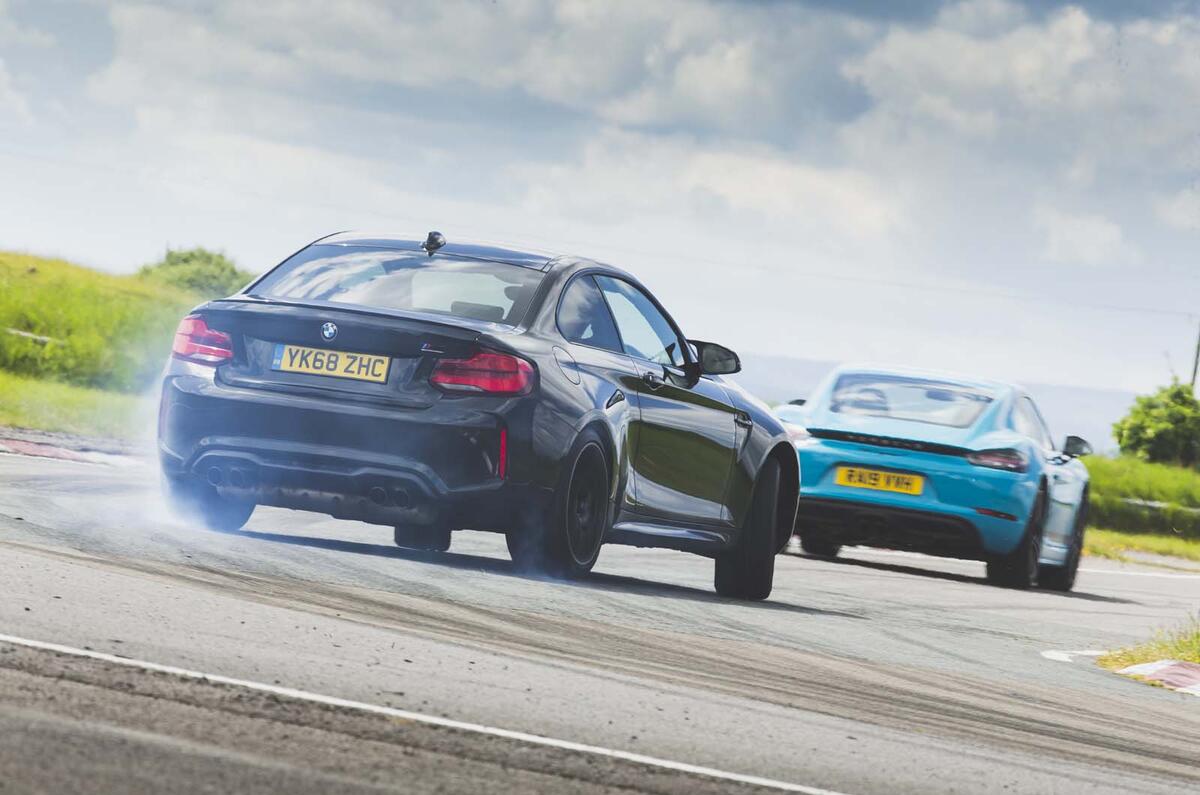
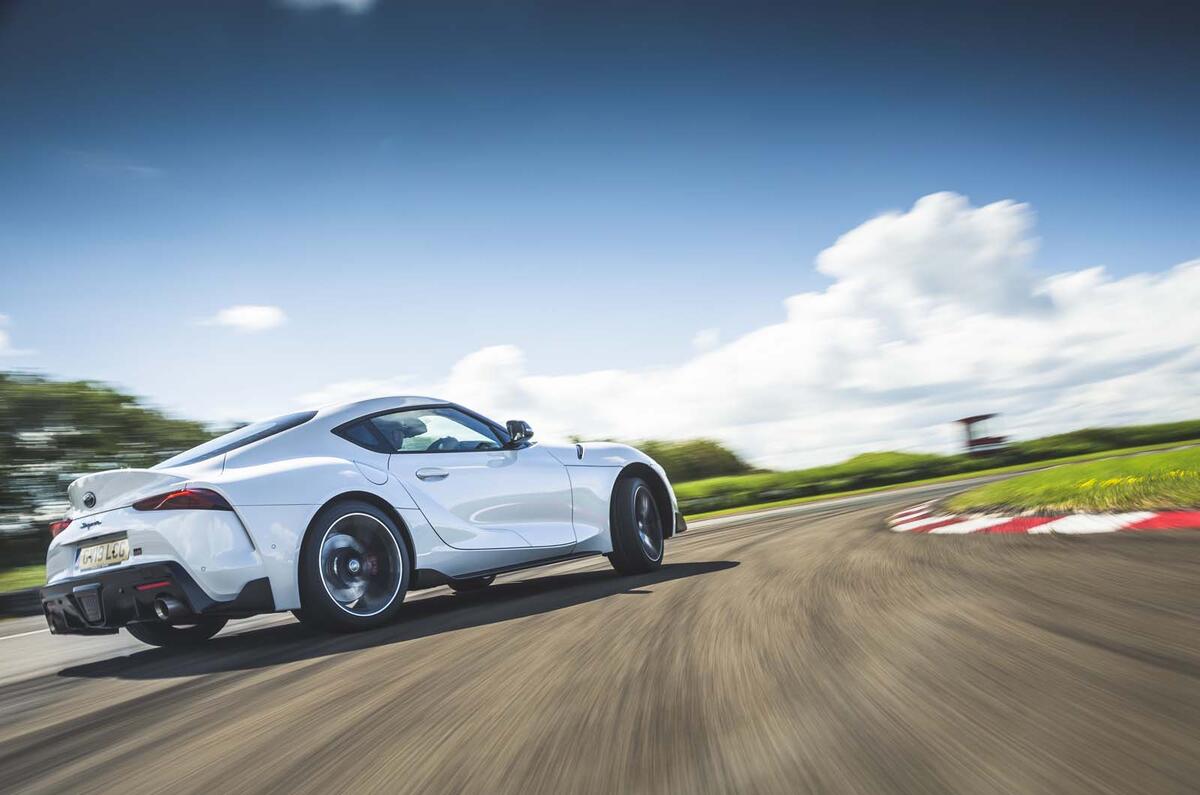
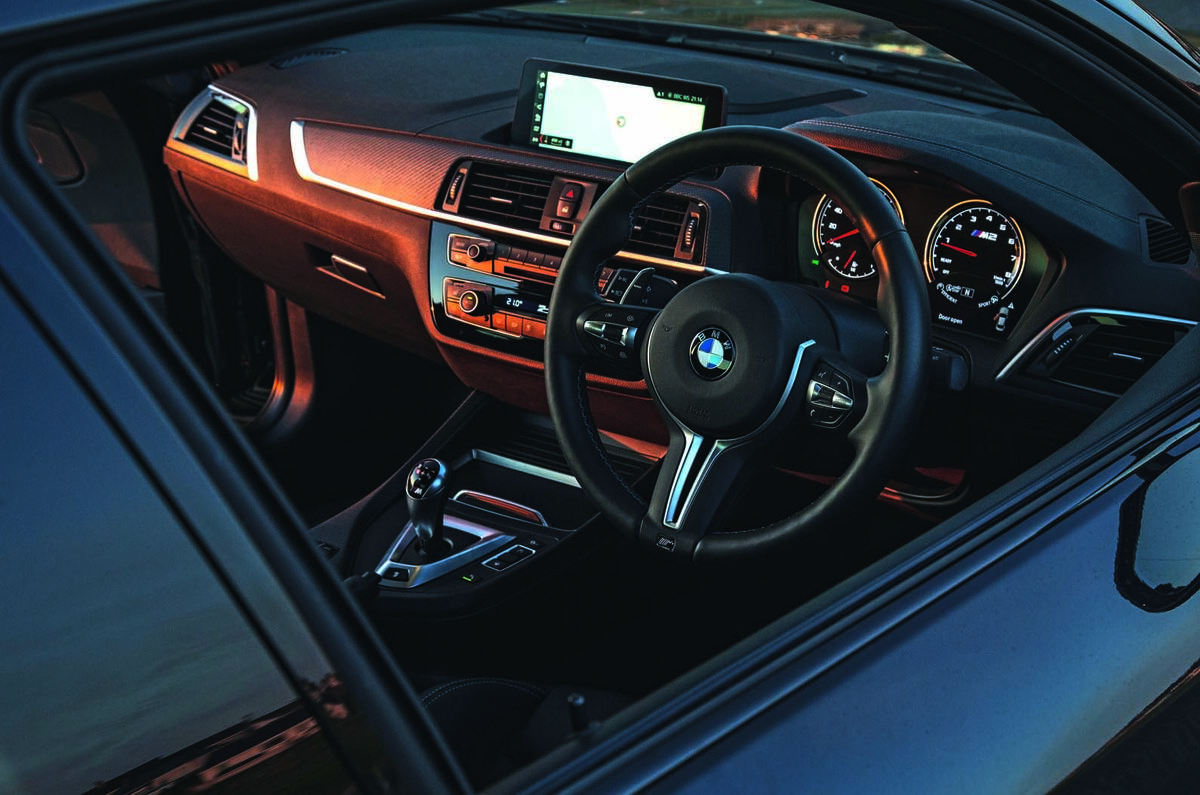
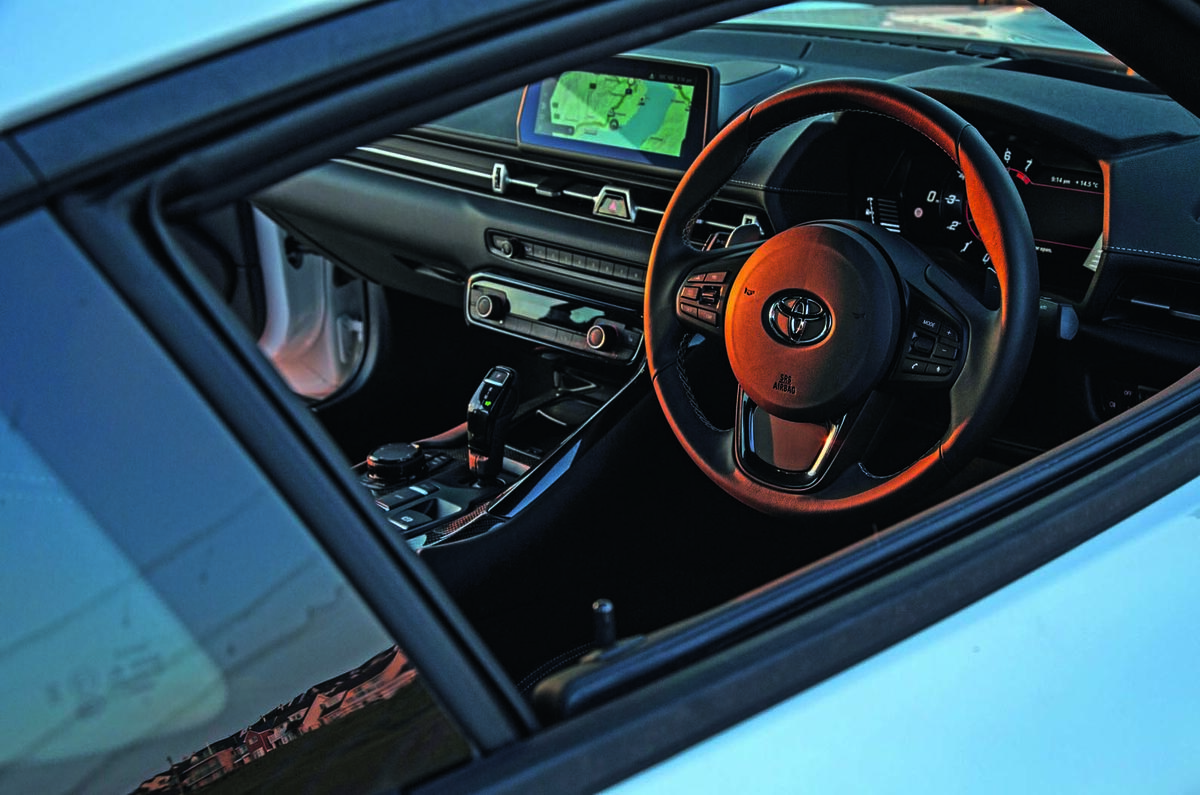
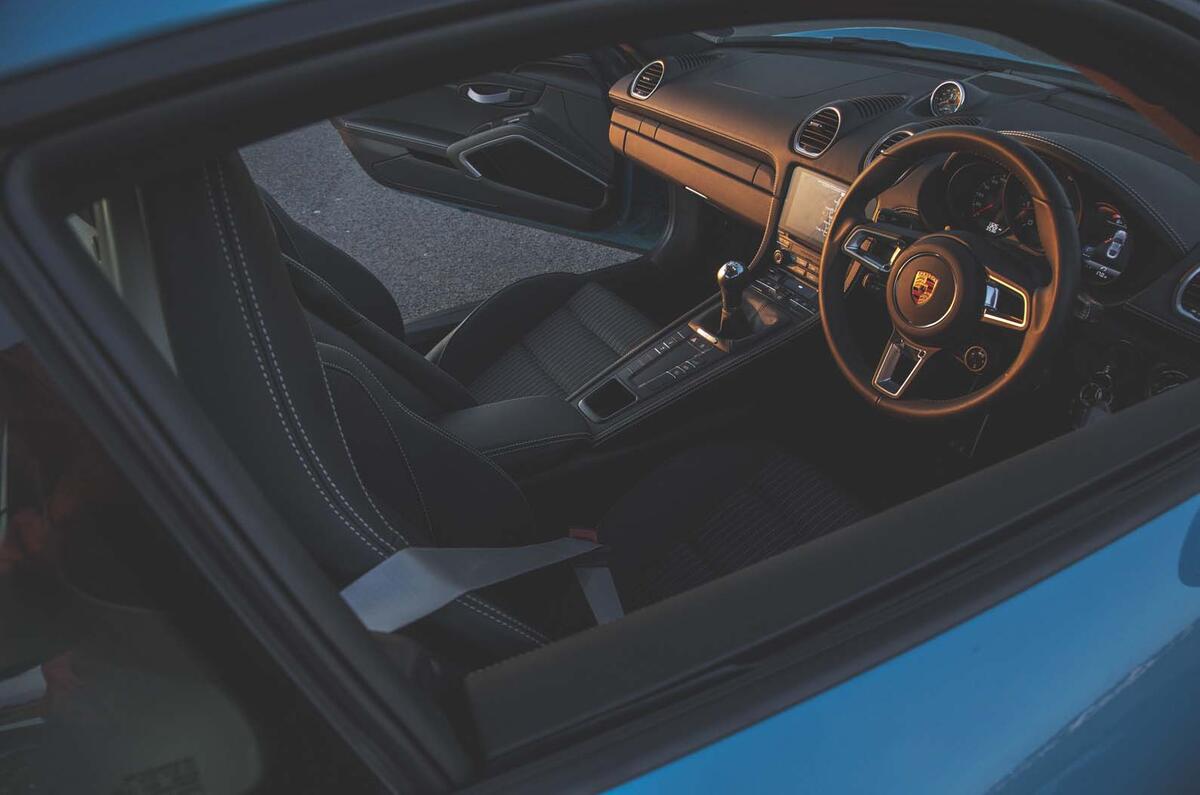
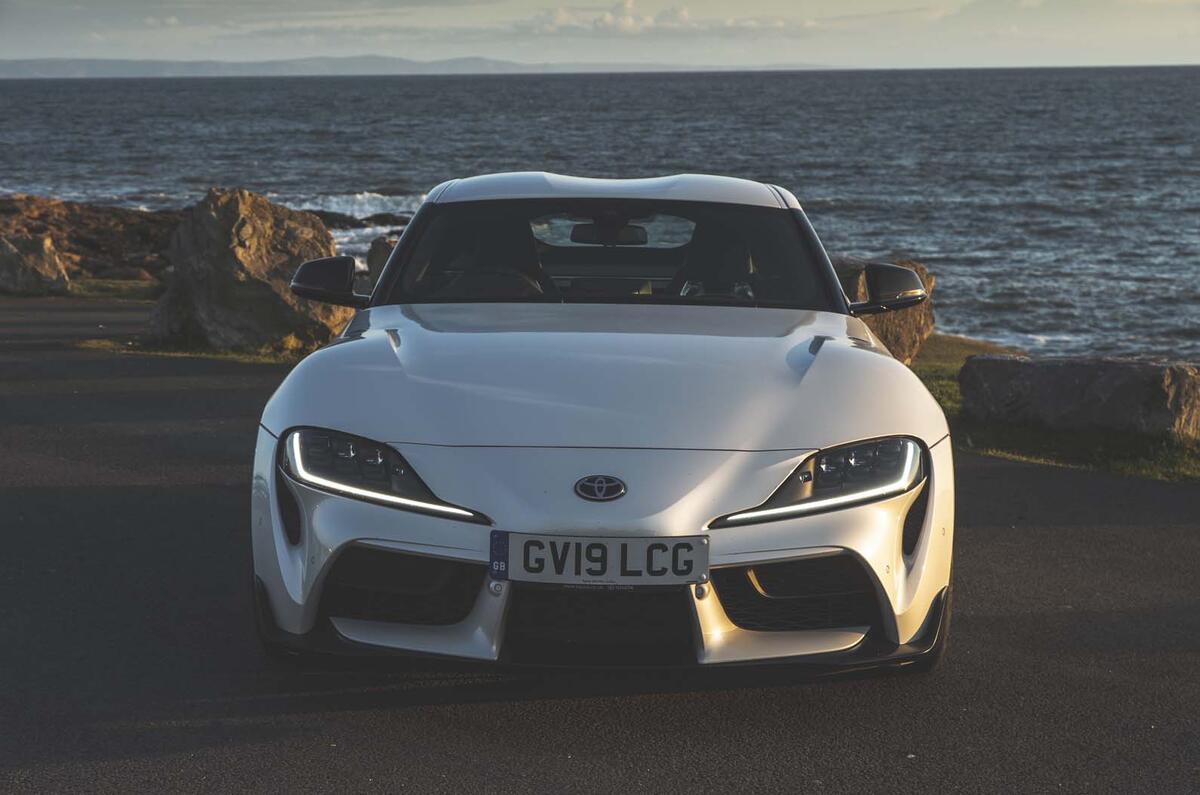
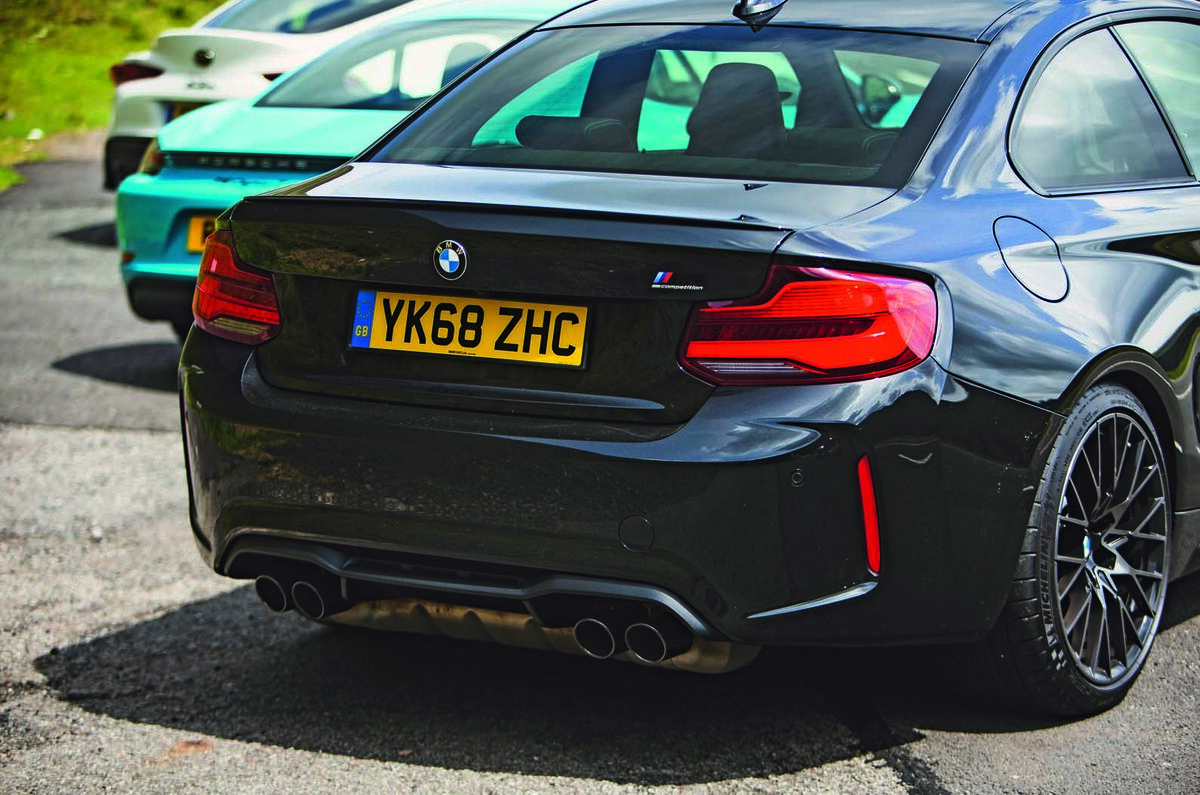
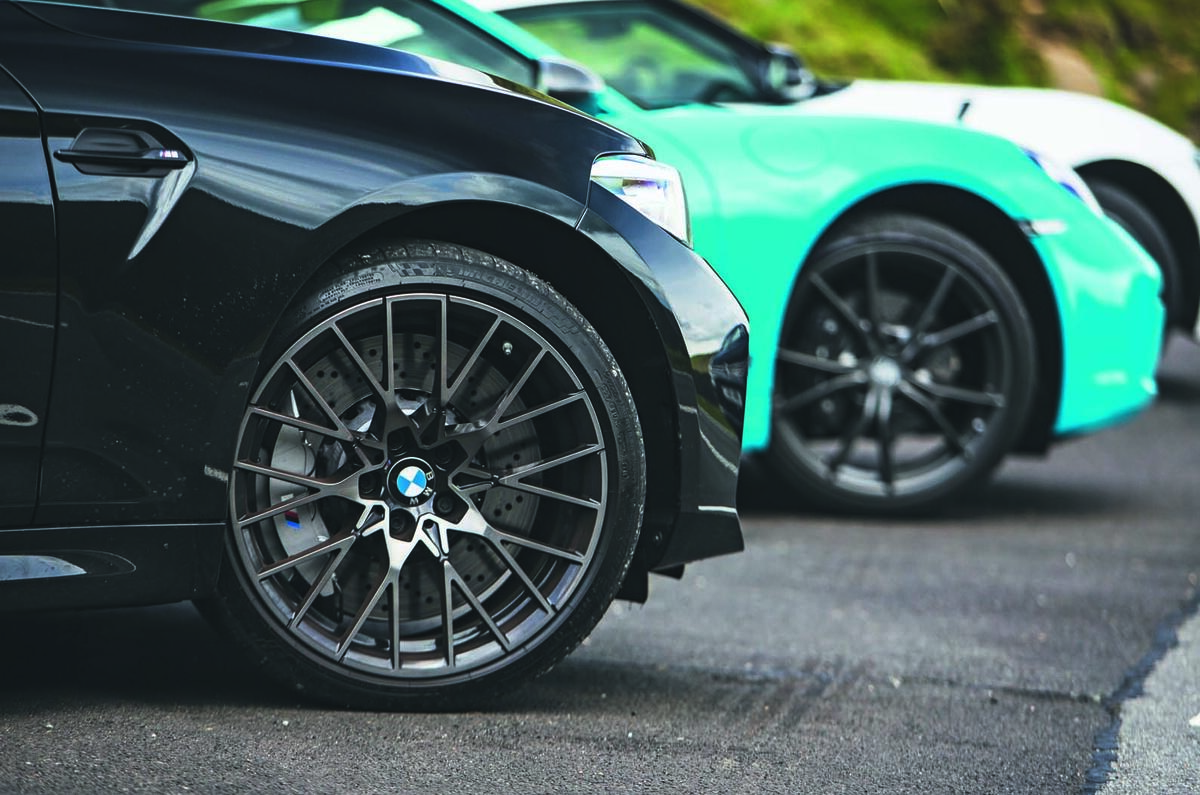
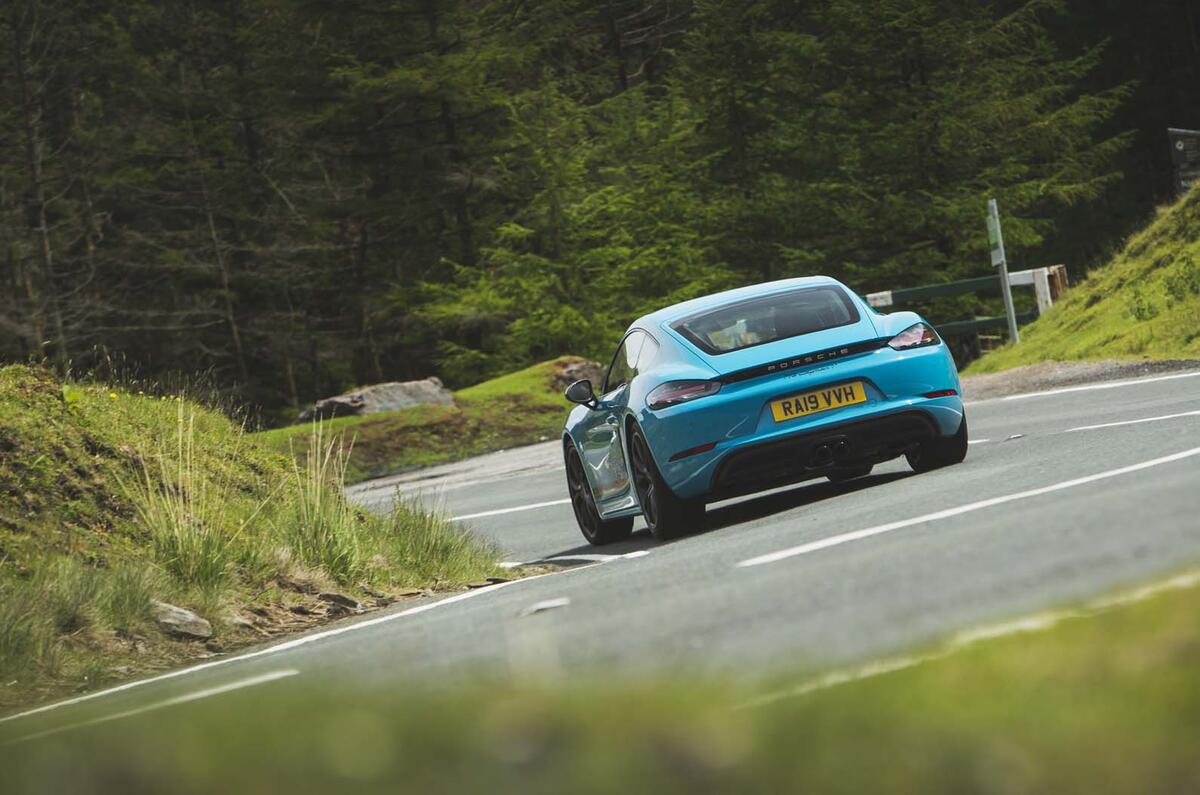
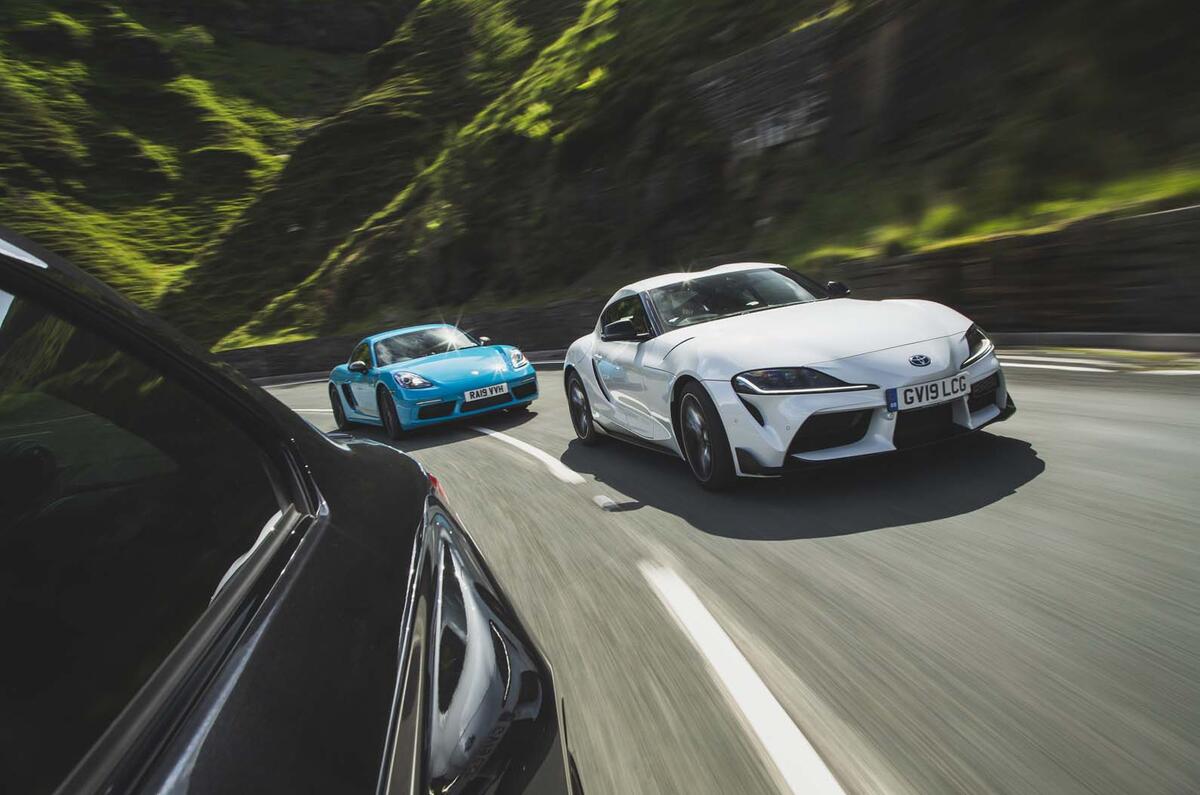

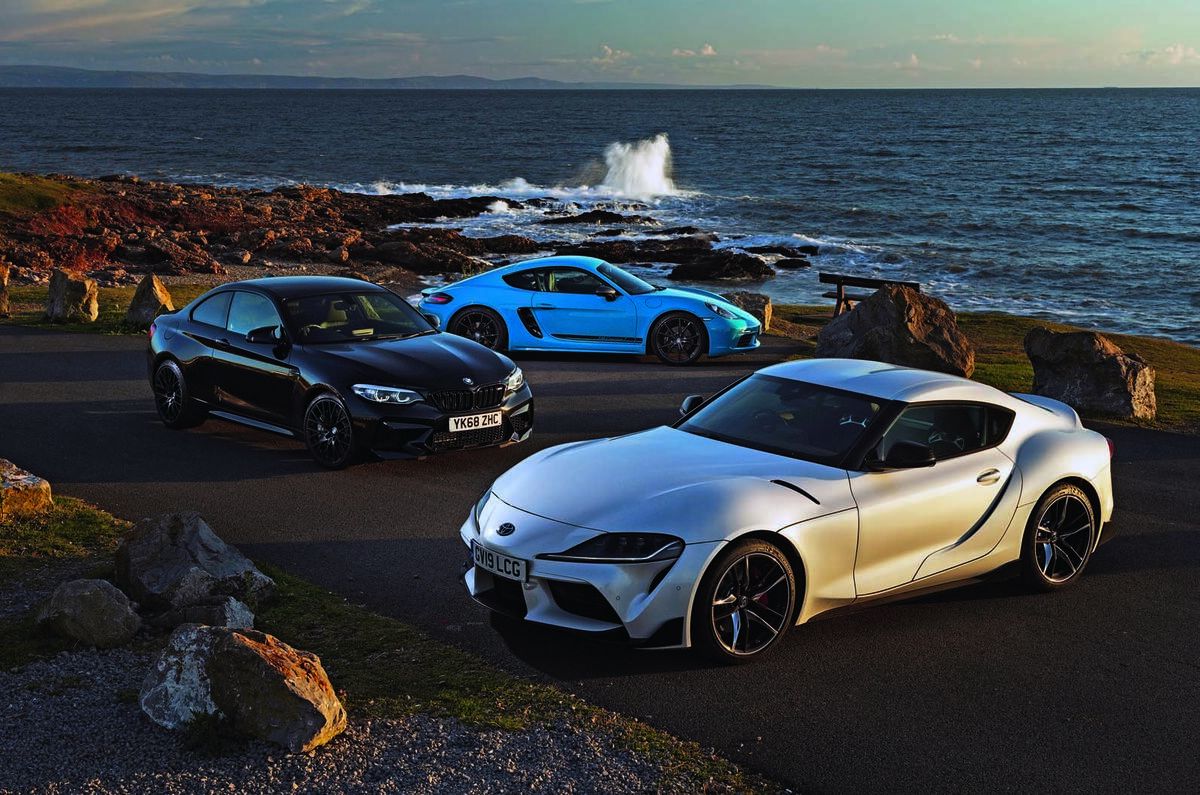
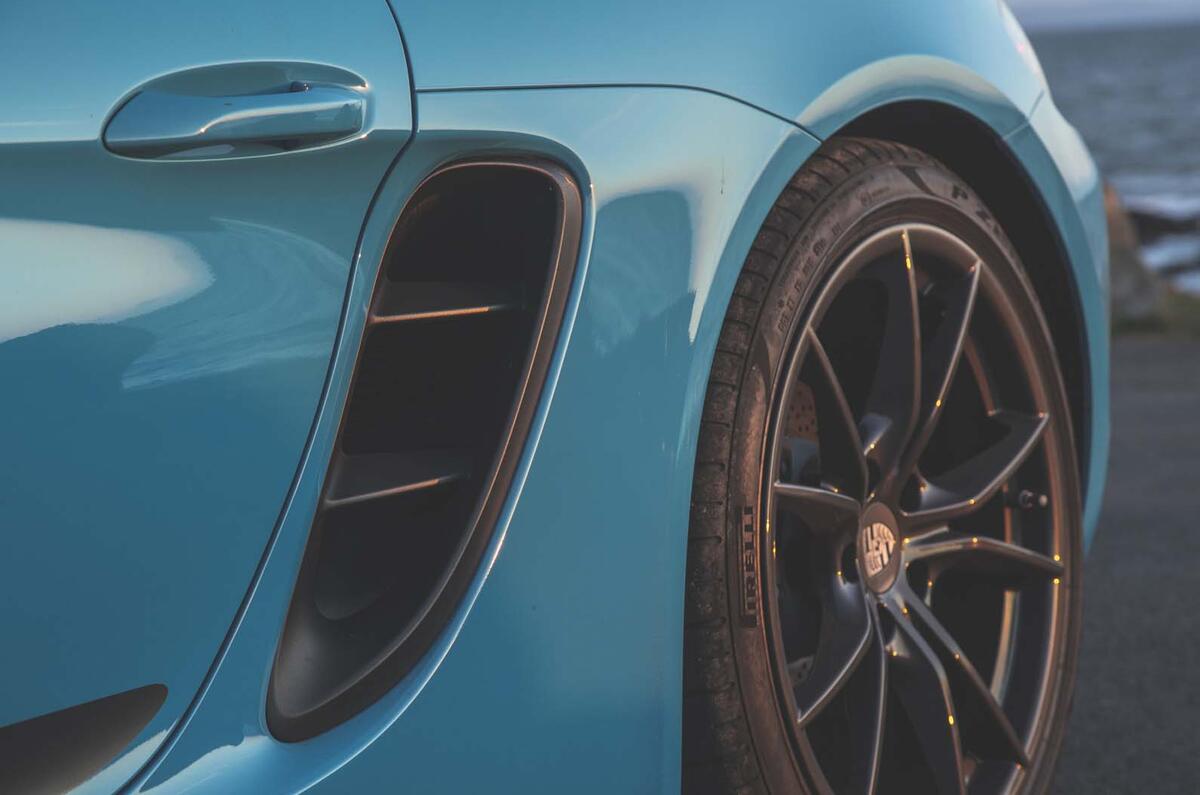
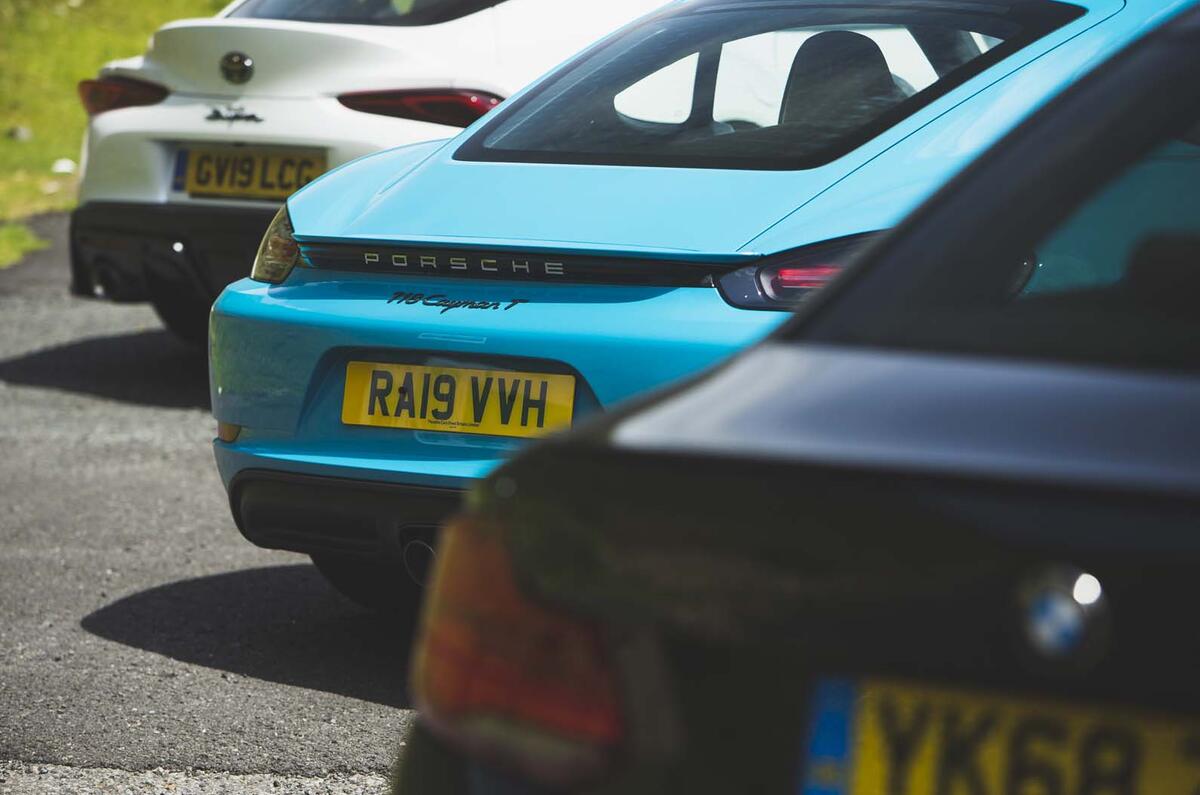
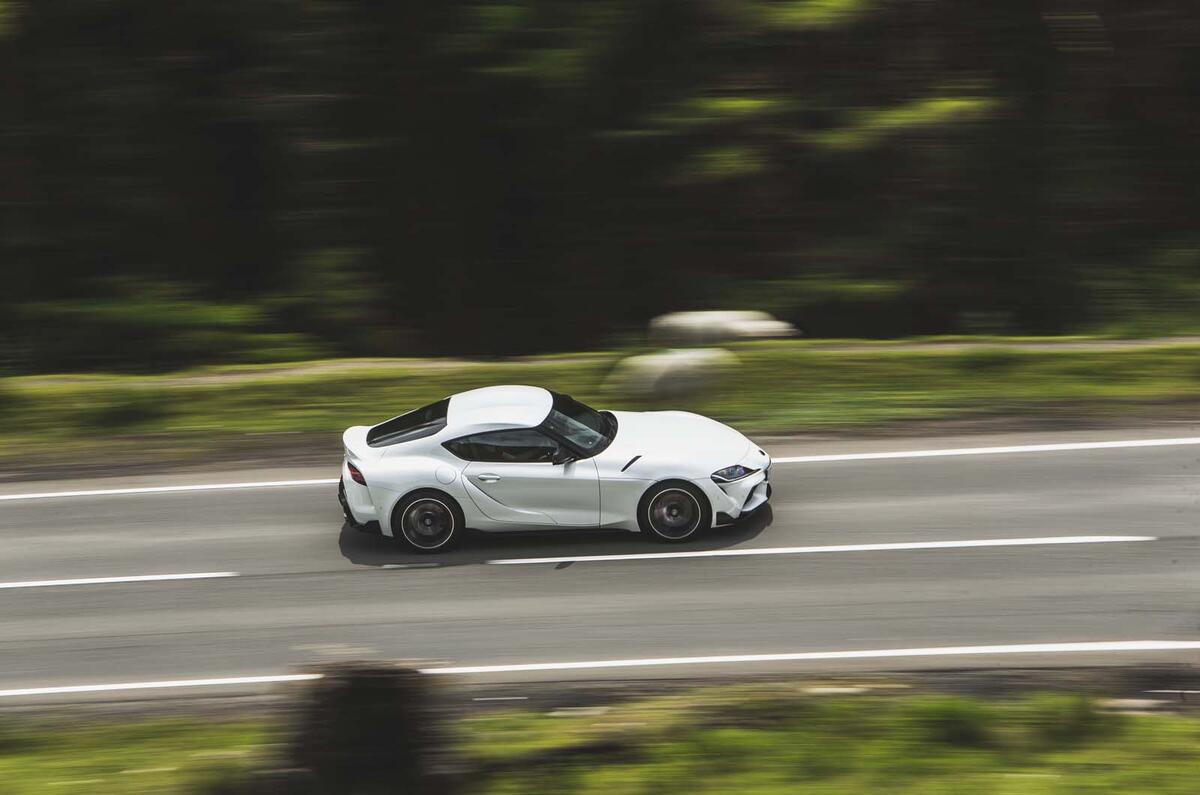

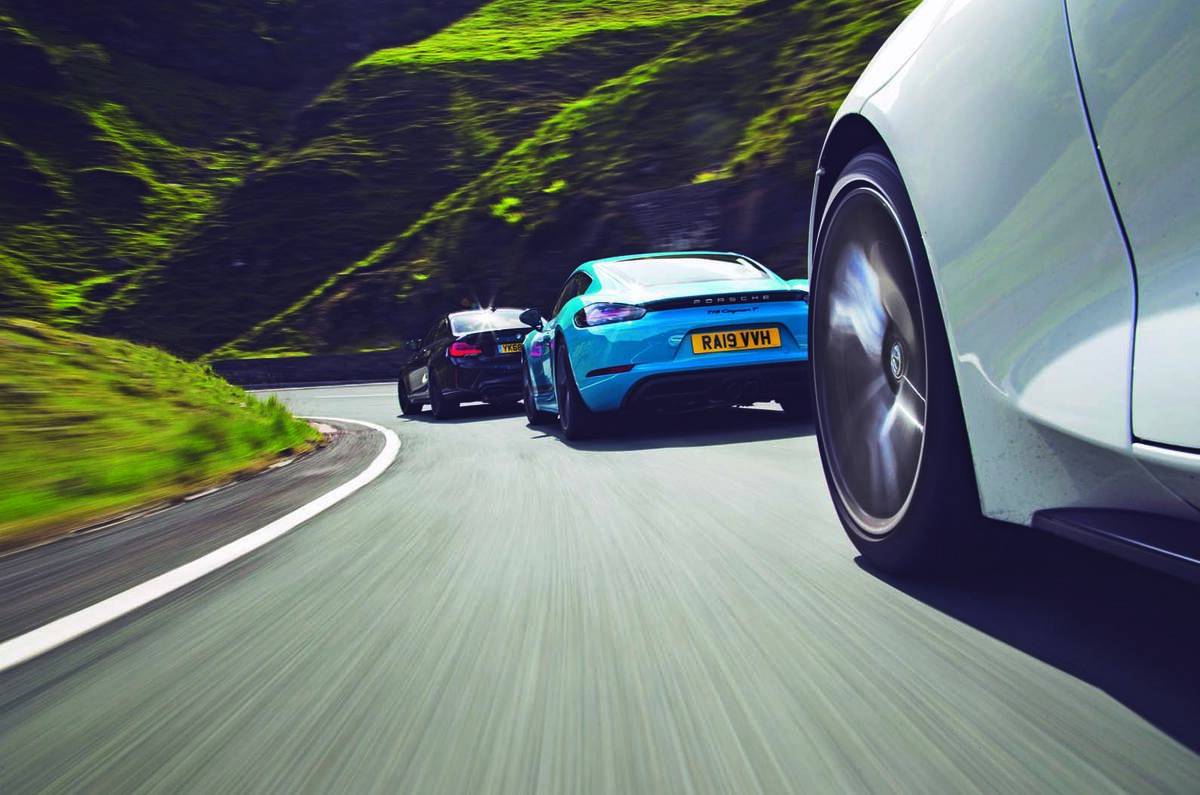
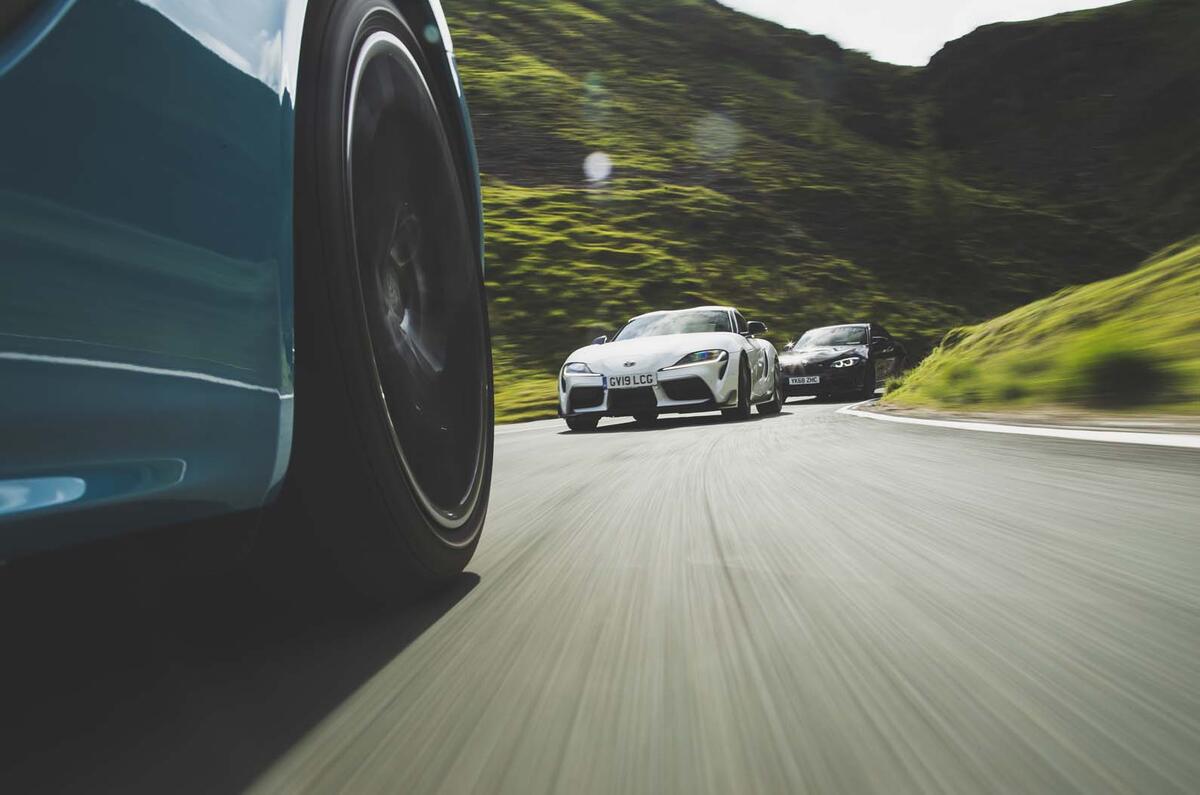
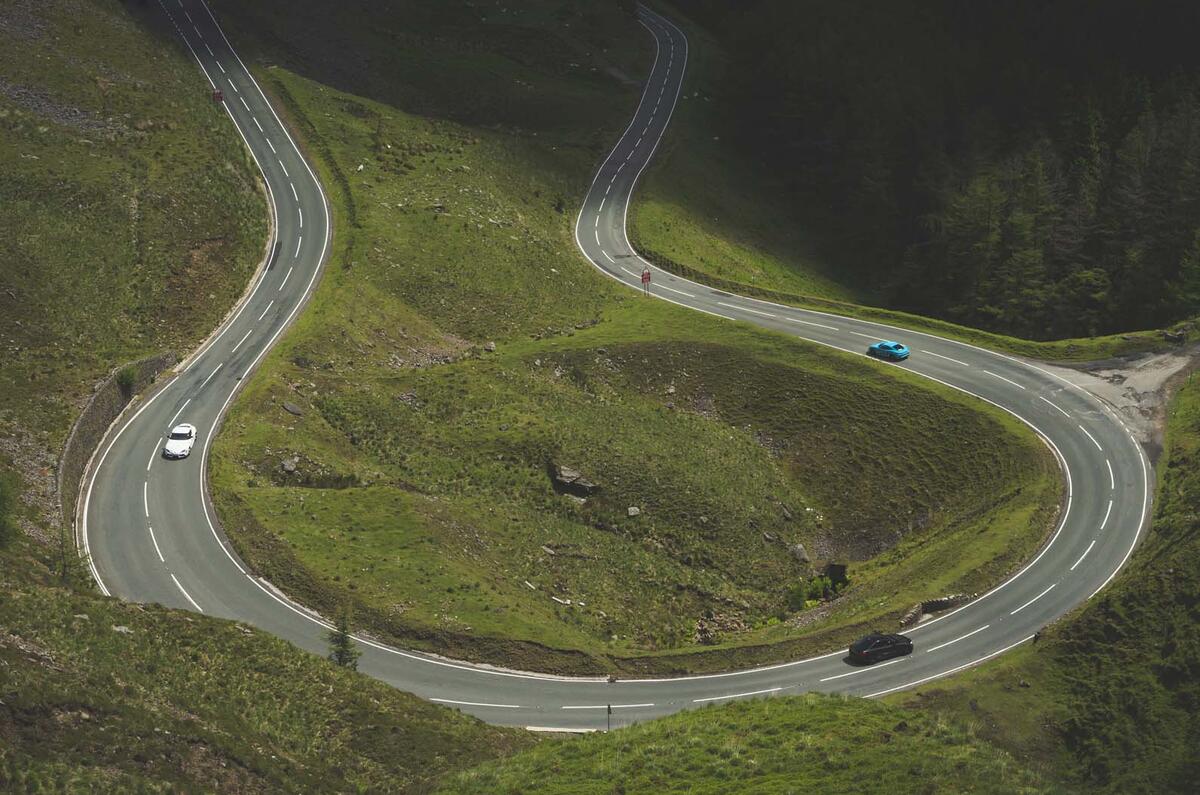

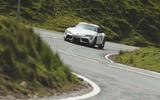
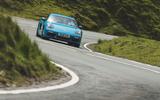


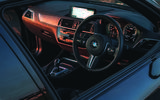
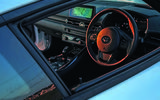
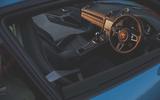



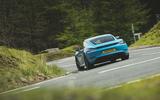
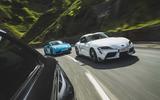


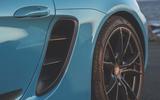











Join the debate
Add your comment
A wish.
I think often it would be nice if posters stayed on topic and put over their opinions in a polite manner, there's really no need to berate, or correct or insult , if a poster has the wrong info, then by all means inform him of the correct ones, I'm trying to write this this way because on some posts there's too much handbagging, anger, it's only a web page on Cars etc, so, anyway, there you go, I hope you all have a nice Lunch.
Great to have James D aboard!
I can literally see the oh so very explicit and descriptive road test writing skills passed down from John Barker- no doubt the mentor here. A very rare set of writing skills, almost never seen in Auto mags for a great many years now. Great to see the handling of performace cars really isolated into dry roads, wet roads, B-roads, up to the most testing bump riddled ones...decribing all the way through how each car behaves and feels,
I have to wonder (as i have for many years) if any front eninge machine can handle with as much predicability, poise and control as the best from Porsche. It may be that longer, more nose heavy front engine cars, simply will never match something like a Cayman. I bet a few hatches would actually have more traction, have greater stablilty and predicabiity down most roads, than a Cayman. A Civic r, a lightened Focus rs, or classic (1st or 2nd gen0 Impreza, would prove a great comparison. We need a real front vs mid vs rear engine handling shootout, I will always remember how Barker would tell me how a 911's rear engine was actually more predicable to drive hard than a Cayman. J
IT had to be the Toyota
I mean, it was just released and had to be made good in comparisons